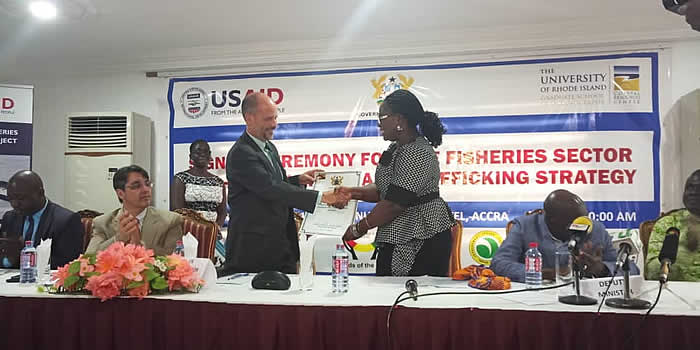Adverts
AGRICULTURE
Fisheries Ministry to implement strategies to eradicate child labour and trafficking in the sector
Ghana has moved to consolidate gains made in its efforts at eliminating child labour and trafficking in the fishing sector.

Date Created : 10/24/2018 10:08:47 AM : Story Author : Dominic Shirimori/Ghanadistricts.com
This follows the signing of the Anti-Child Labour and Trafficking document on Tuesday October 23, 2018 at the Central Hotel in Accra.
The document which was developed by the Ministry with the assistance of its partners, especially the United States Embassy is to provide guidelines to assist the Ministry and its relevant stakeholders to effectively deal with the menace of child labour and trafficking and bring it to the barest minimum if not eradicate completely.
The country was upgraded this year to Tier 2 for demonstrating increased efforts to prevent trafficking, protect victims, and prosecute traffickers, having been on the Tie 2 Watch list of the US Government’s Trafficking-in-Persons.
Speaking at the signing ceremony, the Minister of Fisheries and Aquaculture Development, Elizabeth Afoley Quaye, stated that whereas the International Labour Organization Reports that by the end of 2016 there were 152 million children in child labour and 73 million in harzadous work, Africa was the leading continent contributing 19.6%.
Also, the US Department of State data indicates that as many as 600,000 to 820,000 men, women and children are trafficked across international borders yearly, with approximately 50 percent being minors with the major source of the trafficking coming from poor and vulnerable communities.
“It is reported that 2 million children are involved in child labour and 200,000 in worst forms of child labour in Ghana. The US Department of State Trafficking in Persons (TIP) Report has consistently included Ghana as a source, transit, and destination country for men, women and children who are subjected to forced labour or sex trafficking. As recently as last year, Ghana was put on the Tier 2 Watch List, the lowest category before Tier 3 which requires an immediate cancelation of US development assistance”.
Madam Afoley Quaye noted however that she will never allow the future of children to be jeopardized by using them to provide fish for the populace. According to her, there are problems in the fishing sector, with fishermen struggling to make a living, thus a lot are resorting to using illegal methods of fishing including the exploitation of children to achieve their goals.
“In Ghana, over 50,000 children are believed to be trafficked annually get involved in fishing in our inland bodies, particularly along the Volta Lake. It must be stated that there is no child labour in aquaculture and very limited in the marine subsector”.
She stated that CLaT infringes on the rights of the child, and affects children's physical and mental health and has significant implications for social and economic development at the individual level, household level and for Ghana’s whole society, hence all and sundry must be concerned and assist to eradicate the practice.
The Minister said, though Ghana has been working against CLaT through laws, and ratification of a number of international conventions and treaties among others, they need to be complemented by a dedicated and comprehensive strategy that focuses on eliminating CLaT in fisheries.
Strategies For Eliminating CLaT
According to the Minister, specific, strategies outlined in the document to deal with CLaT include:
• Child rescue,
• Rehabilitation,
• Reintegration, and prevention strategies.
• Community awareness creation and behaviour change communication,
• Improved investigation and prosecution of offenders, and overall institutional strengthening and capacity building strategies for the future.
The Strategy is built upon the ‘Five 5 Ps Framework’ namely Strategy, Prosecution, Protection, Prevention and Partnership.
The Strategy outlines six key objectives as follows:
a. Reduce CLaT by 60 percent CLaT through new rescue and referral protocols;
b. Develop rehabilitation and reintegration protocols connected to anti-child labour and child trafficking interventions;
c. Prevent at-risk children from being recruited into child labour and trafficking;
d. Mobilize civil society and promote community awareness and behavior change to address CLaT at the source;
e. Work with other relevant government institutions to promote coordination among stakeholders and sectors;
f. Promote speedy and effective prosecution of offenders.
Christopher J. Lamora, Charge d’Affairs, US Embassy also described Ghana’s upgrade as a monumental milestone, but calls for continues and increased dedication on the part of major players including ministries to improve the overall effectiveness of fighting child labour and trafficking within the fisheries sector at all levels.
He asserted that a holistic, integrated, and multi-sectoral approach is required to ensure a fisheries sector that is free of child labour and trafficking. “I’m confident that this strategy bolsters the Ghana government’s commitment to this goal, and it highlights our cooperation to eliminating all forms of child labour and human trafficking”, and called for effective participation of the media in this fight.
Other stakeholders including the police and CNACT all called on government to religiously implement the strategies as contained in the document o help the country achieve its target of eliminating the menace.


 facebook
facebook twitter
twitter Youtube
Youtube TOLL FREE 0800 430 430
TOLL FREE 0800 430 430 +233 593 831 280
+233 593 831 280 GPS: GE-231-4383
GPS: GE-231-4383 info@ghanadistricts.com
info@ghanadistricts.com Box GP1044, Accra, Ghana
Box GP1044, Accra, Ghana